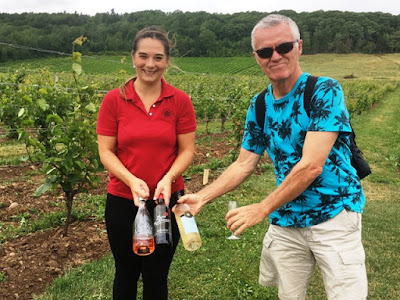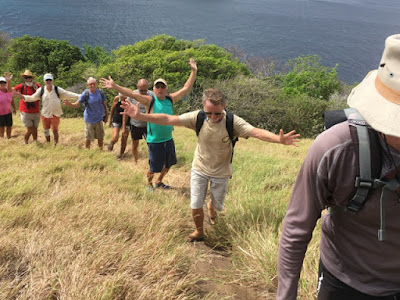Dawn and I are back in our cute, cozy cottage on Grand Lake,
NB. We moved out of a tiny house and into a slightly larger tiny house! The season was great, but it is also
nice to be staring into the fire, watching television, looking at the foggy
ice, taking hot showers, and dropping dirty dishes into the slot in the
dishwasher. Having real bandwidth is fun
too. I’ll be waiting until next week to
set up the hot tub and clean up the yard.
We are looking forward to attending a wedding in St. Andrews on Saturday,
and we’re rushing around for appropriate attire.
I would like to take the time here to acknowledge Hugh
Whalen and Liz Abraham. We landed at the
Fredericton Airport late Tuesday, and simply walked out and into their car to
be whisked to their home for pizza and refreshments. Hugh had my car at his door, with the battery
charged, so we could drive the last miles to our own home.
Hugh checked on our cottage every Sunday for all of the
winter, as he has since we started this.
He also does this service for the rest of the neighbourhood. We could not do what we do all winter, every
winter, without Hugh; and it is impossible to make it up to him, or even
properly explain what it means to us.
Liz writes to us every Sunday to keep us up to date of the happenings at home.
We started our weblogs back in 2004; and for the first two
years, the weblog did not accept pictures.
Well, we are almost back to that, as we just did not take the pictures
we need at the end of this season. Well,
we’ll do what we can...
We had a lovely sail down to Carriacou on the 29th
of March, timing it to clear Customs without holiday charges; and we stayed 8
days before heading to St. Georges, Grenada. Our time in
Carriacou was slow, with us ramping up on our work to put the boat away: Dawn
cleaning inside areas with strong vinegar/water solution to avoid possible mold,
Laurie starting engine work and doing some gelcoat repairs. Except for some fun with Joanna and Bill of
s/v Baidarka and Cathy and Tom of s/v Jumby, we stayed quiet with the work,
some puzzles, and getting a bit of exercise.
 |
| Just how many people can fit on Peggy's Rock? Always room for one more, just like a Caribbean bus/van! This was taken back in Bequia. |
 |
| Anina (s/v Prism) found a secluded spot dangling over the airport runway! Anina often organizes our hikes and challenges our legs and bodies! |
The trip to St. Georges was also an easy, fun sail; and
after trying to get holding in the anchorage outside the harbour, we stayed
only one night before going into the marina of Port Louis for two nights. We washed and waxed the exterior of the boat
and enjoyed two lovely meals before motoring around the corner and into Prickly
Bay. There, too, we got ashore for some
meals and fun, but focused on oil changes and interior cleaning. We did get on a Hash hike with Cindy and Dan
of s/v Sittatunga, Kim & Dean Martin
of s/v Dream Catcher, and Ken & Grace of s/v Pisces.
Haulout was normal on Tuesday, April 17th, and we
went directly to work to make the best of the short six days on the hard.
The season, in retrospect was a wet and windy one. We did well to get up to Dominica; and
indeed, with the amount of destruction caused by the northern hurricanes, there
was little reason to go further. We
spent an inordinate amount of time in St. Anne; enjoying the crowd of old and
some new friends there. We had an
outrageous Christmas party on s/v Tarantella, and a killer New Year’s party in
our cockpit with 12 of us.
Interestingly, the season was filled with so many friends in all the
southern anchorages (not a chance to name them all), that having cockpit
cocktail parties were curtailed in favour of afternoon lunches ashore, usually
after a hiking party. Still very
enjoyable.
The sailing, for me was lovely, though limited to the very
few weather windows the season provided – but for Dawn there were a couple of
crossings she would have rather missed.
The trip between Dominica to Martinique was one!
The season saw the end of Denis’ weather, a revival of the
FOD SSB Net, great hikes with crowds, fantastic lunches, and sadly, the end of
Lorna and Brian’s Caribbean experience with s/v Peace and Plenty.
Lastly, we got three articles published in the Caribbean Compass. You can see the latest one here, in April’s on-line version, on page 30-31:
http://www.caribbeancompass.com/online.html
We're ending this season's blogging with a little story of Dawn being a hero:
When we paid for a 2 day stay at Port Louis Marina, we had time to eat out and laze a bit by the pool in the afternoon once the work was done. I was reading a book while Dawn was watching 3 little children (about 2, 4 and 6 years old) all decked out in their waterwings play with their mom and dad. They were very entertaining and the parents were most attentive. At one point, the oldest daughter took off her waterwings to show mom and dad that she could swim a few strokes. This went on for awhile and eventually, Dawn spotted the 4 year old getting out of the water and taking off her waterwings, evidently wanting to copy the older sister's actions. Dawn watched carefully, knowing that neither mom or dad had picked up on this turn of events. The little one walked the 3 steps into the pool and simply sunk. Not a peep, no flailing, nothing, just a cloud of hair on the surface. Dawn sprinted over screaming all the way. The parents pulled her out and nearly fainted at what might have happened. The mother asked later how long we thought the child was under and we were happy to report that it was a matter of seconds. Glad this turned out well.
 |
| These are little pottery fish bought from an artist in Bequia. They will go with the 2 large pottery fish that Dawn bought from the same artist last year. |
 |
| Cat Tales at the dock in St. George's, Grenada. This is where we worked to wash and put leave-on wax on the outside of the hulls to save time once we're hauled. |
TECHNICAL
I’ve been offered some technical assistance by my friend
Roger Michaud, who intends to get to the bottom of my issue with oil pressure
senders. He intends to test and inspect
the three failed senders as well as analyse the season’s oil filter. I am intrigued.
After the boat was out of the water, I borrowed a grinder
and ground into 8 funny mounds on the interior stern of the hulls above the
water line, until each squirted the yellow, vinegar-like substance that proves
the bumps are related to osmosis. I am
letting them dry out, and will fill them with glass and gelcoat upon our return
in November. I hope to start the repair
process with the low viscosity epoxy: “Git Rot”; so capillary action might
carry the material down the channel that the fluid originally traveled. I will have to do some research on this
first.
 |
| Laurie working with a borrowed grinder and borrowed face mask. |
 |
| Pungent water oozing out of one of the osmosis bumps Laurie grinded out. |
 |
| You can see the osmosis byproduct seeping down the side of the hull over the hull stripe. |
 |
| This heavy fitting's threads failed to hold back the 900 psi water of our watermaker, and got eroded. |
We also took out the port escape hatch, on the inside and
down by the waterline. We had become
convinced it was leaking and, indeed, the caulking had failed. We think the caulking failed because of the
manufacture of aluminum salts as the frame corroded. We sanded the frame down and applied an
expensive primer prior to reinstalling to attempt to stop the process from
recurring. Were I to do it over, I would
have sprayed the frame with zinc chromate before the primer, but I didn’t think
it out. We still have to track down the
gasket material for this 1996 hatch before we complete the installation. Wish us luck.
A dismantling and analysis of the watermaker assembly found
numerous parts that need to be replaced.
If something drips at 900 psi, you can expect some corrosion and
erosion.
The mainsail and boombag went into the sailmakers, and
although we have not seen the results, a repair and inspection cost $800
Can. The sailmaker said that it had suffered
some sunburning, and easily ripped the top panel in front of us. Still, that mainsail is from 2004, and it
will hopefully do for another few seasons.
We are also having to make decisions on a new trampoline,
with a probable cost of $1800 Can., and we’ll likely buy new chain in Grenada
this fall as well. The old one just will
not stay in the gypsy any more.
As for the season on Cat Tales, we can say she worked rather
well; requiring not really as much time in repairs as in past seasons; in spite
of the work we are facing.



















































